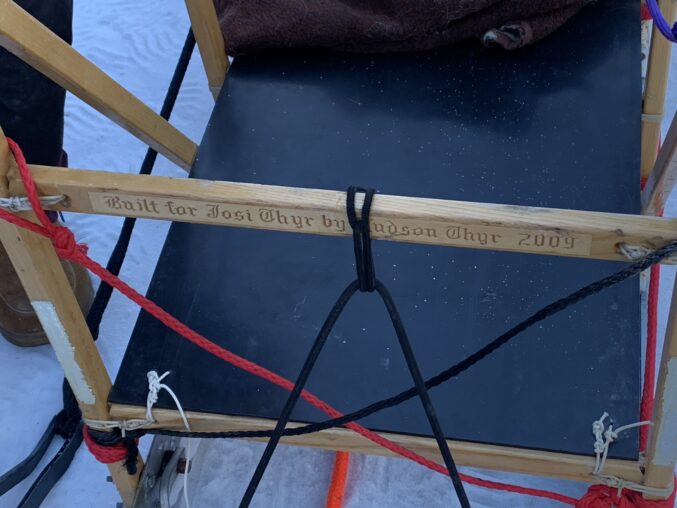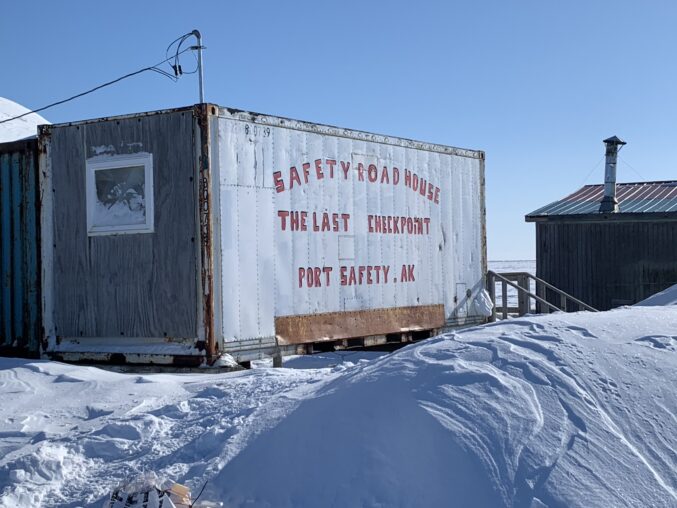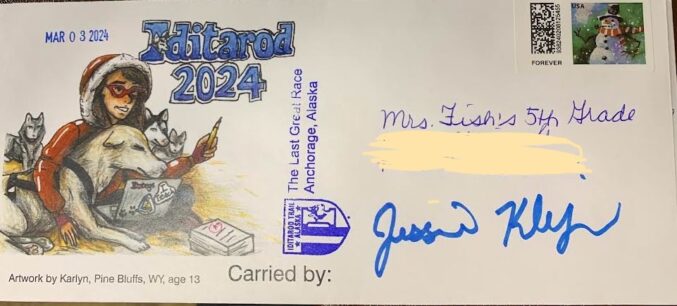Imagine a thick quilt, covered in many squares, patches and fabrics, with layers of warm fiber nestled through, sewn together with thread. On this trip I’ve met so many people who are the threads holding the history of a place together. Their stories weave in and out of the fabric of time. Change happens, and the threadbare quilt is covered with a new layer of fabric. History is in the making all the time.

The carved inscription on the sled Josi Thyr’s grandfather made for her. Photo: K. Newmyer
I got to learn and experience the history of the Seward Peninsula and Nome on my walks through town. I went to the Nome Visitor Center, The Bering Land Bridge National Preserve Visitor Center, and the Carrie M. McLain Memorial Museum. Several local people shared their stories with me. These experiences help me understand better the geology, cultures, wildlife, and historical events of the Seward Peninsula. The Iditarod and the places through which it travels is like a many-layered quilt. Historians study and interpret artifacts, photographs, journals, and printed material. Through these, they can make connections across time.

Port Safety, Alaska sign. Photo: K. Newmyer
During the gold rush and early 20th century before automobiles and airplanes, dog mushers hauled freight and supplies. Mushers got together to race their dogs, and the All-Alaska Sweepstakes was born. It started in Nome in 1908 and went to Candle and back along the Bering Strait. Looking at photographs and artifacts from these early races, I noticed that the early time sheets look very similar to the digital ones used today. Place these images side by side and have students compare the Iditarod time sheets found on the web site to the All-Alaska Sweepstakes ones. What information is the same, and what is different? How is the information delivered?

Joe Redington, Sr. was convinced that a sled dog race would keep the culture of sled dogs alive, and so the Iditarod was born fifty-two years ago. The All-Alaska sweepstakes was revived in 1983 and won by Rick Swenson, a five-time Iditarod champion, and in 2008 by Mitch Seavey, a three time Iditarod winner and the father of this year’s winner, Dallas Seavey. The threads of people’s stories tie a hundred years of sled dog history together.

2024 race stats from Iditarod web page.
If you have access to Iditarod artifacts, share them with students and have them notice and describe what the race was like in past years. These artifacts might include dog booties, race guides, newspapers, souvenirs, Trail Mail, winter clothing, and photographs of places, people, and dogs. Have students engage in a scavenger hunt to describe the object, what they think it’s made of, who made it, why it was made or what it was used for, and what they can infer about history from the object. I like to ask students, what do you think the people valued who made this object? What questions come up when you examine the artifact?

Downtown Nome, c. 1910. Photograph from the Carrie M. McLain Memorial Museum.
Throughout this post are images I took from the last few days, and you can use these to help students become historians. First, model thinking critically about the object and how it represents the history you are teaching. Then make sure you have lots of different kinds of artifacts and information to help put a single event in context. Students can solidify their learning by writing persuasively about history.
Students studying history benefit from small group and large group discussions to help process and reflect on their learning. Structure these according to what works best for your students. Also consider historical reenactments, recreations, and debates. Students could research about mushers from the past and present, then have a discussion or debate about the mushers’ experiences in the 1910s, 1970s, and 2024. They could present about an artifact as if the artifact was speaking. Imagine what a sled dog harness would say? What about a return dog blanket, an Iditarod commemorative coin, or a piece of Trail Mail?

The Iditarod is rich with history. Make sure you interweave artifacts, objects, and photographs with your lessons, so students have perspective and understanding of people’s stories and experiences throughout the fifty-two years of the Iditarod, and the thousands of years of dog mushing in the Seward Peninsula.
Share with me how you teach Iditarod history with objects and photos. Email me at emailtheteacher@iditarod.com.


